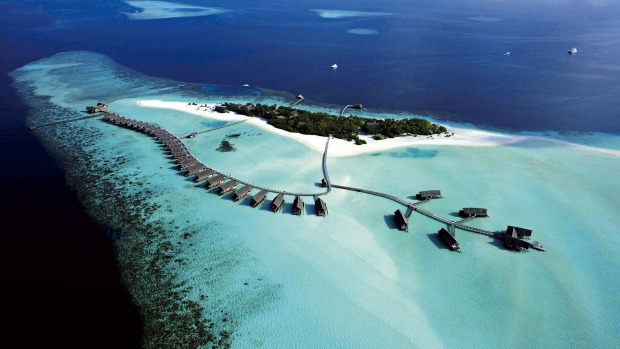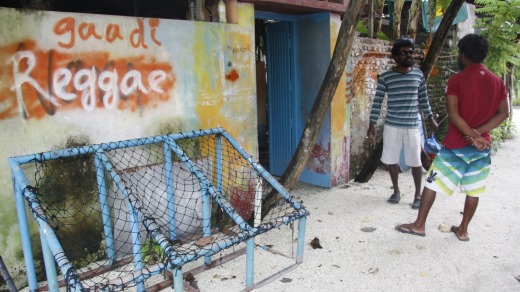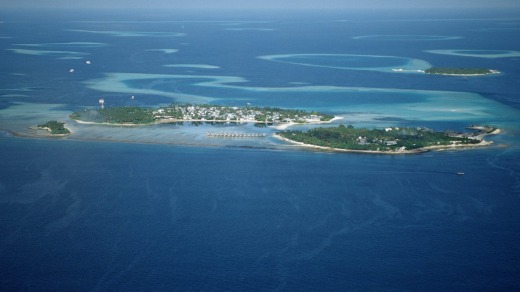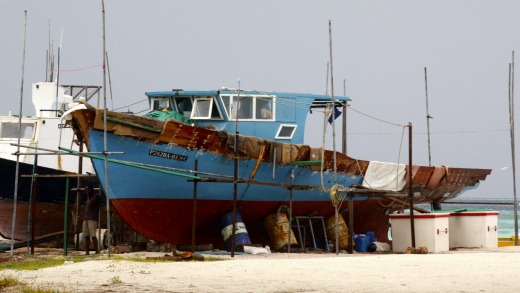
It looks like a game of tennis, played backwards. The girl serving has her back to the net and swats at the tennis ball with a racquet, hitting it into a court she can't see. That's not the only difference. Her "opponent" is a gaggle of teenaged girls wearing hijab headscarves and leggings under their sports tunics, standing at the net, eager to catch her out – making the game suddenly more like cricket, without wickets. This is bashi, a women's sport played only in the Maldives. Who knew?
It's no surprise we didn't. Most visitors to this island nation in the Indian Ocean are whisked away as soon as they land in Male. Actually, most never even set foot in the over-crowded capital, because the international airport occupies its own island right next to it.
That's one of the joys of arriving in the Maldives. Breeze through customs, pick up a free tourist visa, collect your luggage and step onto a boat or seaplane for the short trip to your island resort across the country's famously turquoise water. No queuing for taxis, no haggling over fares, no bus tickets or tourist maps. Just: hello, here's your lifejacket, enjoy the ride.

But all this ease has a cost: there's little opportunity to experience Maldivian culture or see how Maldivian people live.
Only 200 of the Maldives' almost 1200 islands are inhabited. So I jump at the chance to visit one, Guraidhoo, 10 minutes by boat from my over-water bungalow at Cocoa Island by COMO in Kaafu Atoll, south of Male.
The two-hour walking tour begins at Guraidhoo's concrete ferry wharf, where resort guide Abbas gives my friends and me a brief history of the island.

Guraidhoo has been inhabited only since 1970, he tells us. Back then it was home to doctors treating leprosy patients on two neighbouring islands. By 1975, their work was done; there was no more leprosy in this part of the Maldives. When the doctors moved on, their former patients moved in.
Now the island has 2700 people, who live in colourful concrete houses or older ones made of coral chunks. Most work in tourism (at nearby resorts or at new locally owned guesthouses opening up on islands like this), health care (there's a large psychiatric hospital serving the area) or boat building (we see an enormous cruiser under construction in an enormous corrugated iron shed).
As we walk the sandy streets, there are reminders of two facts of life in the Maldives: its dependence on foreign aid (we see solar panels donated by China and Japan, an ambulance funded by America, a pre-school built by Russia) and its vulnerability to natural disasters.

The Boxing Day tsunami in 2004 came close to destroying Guraidhoo. Forty-five houses were washed away and 14 people were never found. People lived in tents and survived on government handouts – many lost their jobs when seven of the nine resorts nearby closed for repairs – until the American Red Cross helped rebuild the town.
Because it's Friday (one of two "weekend" days, the other being Saturday), it's relatively quiet. But we see a few people, besides the girls playing bashi: women in hijabs and full-length dresses (all Maldivians are Sunni Muslims), boys doubling each other on bikes, two guys outside a (closed) reggae bar and some older ladies and gents in string hammock-chairs listening to a radio broadcast from a wall-mounted speaker across the street.
Too soon, it's time to go and because we're heading to Male's airport island for our flight home, not back to Cocoa Island, we can't linger any longer. I shrug "sorry" as we walk past a man beckoning us into one of the island's few souvenir shops. He seems unfazed, then reaches through the doorway and flicks off the lights inside. No customers, no reason to waste electricity. That's life in the "other" Maldives.

www.visitmaldives.com
Singapore Airlines flies from Sydney to Male via Singapore with same-day connections daily; see singaporeair.com. Cocoa Island by COMO is 45 minutes from Male by speedboat; transfers cost $355 return per-person.
Over-water suites at Cocoa Island by COMO start at $1280 a night including breakfast, Wi-Fi and activities such as yoga and snorkelling. Island tours cost $280 per couple. See www.comohotels.com/cocoaisland.